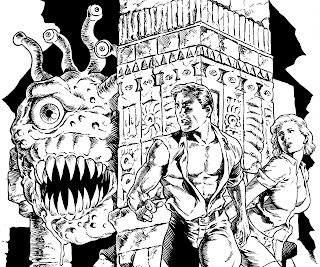 |
| art by "Reno" Maniquis |
Now, this is not to say the standard D&D classes couldn't be used straight in fantasy pulp setting--fighters being the various tough guys, clerics the evil battling priest, etc.--but I think down that run lies something more like Shadowrun, not Captain Easy, Sam Spade, or the Green Lama. Which is not meant to be an insult to Shadowrun, nor to suggest I'm not doing a bit of incongruous genre mashup myself, here. I just don't want to loose that cheap whiskey-esque pulp flavor.
I suppose there are two solutions. One would be to add several more classes--Private Eyes, Gangsters, Mystics, etc., but I’m concerned with what the sheer number of these might be, and (a perennial issue in class base systems) what gets to be a class and what doesn’t. Is an ex-soldier just a fighter, while a gangster’s something different? Or vice versa? Or none of the above?
D20 Modern uses an interesting system wherein the classes are mapped to ability scores. There’s the Strong hero, Fast hero, Smart hero, and so on. This strikes me as a potentially adaptable system as it distills the all the various character types found in different types of pulp fiction to archetypes as unadorned as (maybe) the D&D basic classes are for standard fantasy.
My only concern is, does that take away some of the “flavor” and immediate role-recognition that more delineated classes provide. I suppose there's D20 Modern once again, and the addition of "occupations"--but then have I just exchanged classes for "things that are sorta classes-lite?" Of course, Warhammer FRPG used a similar sort of system, and I liked that implementation there.
Anybody got any thoughts in this regard?
























